The Pseudo-Protic Ionic Liquids TOAH+Cl− and TODAH+Cl− as Carriers for Facilitated Transport of In(III) from HCl Solutions
Abstract
1. Introduction
- (i)
- Liquid–liquid extraction. D2EHPA (di-2-ethylhexyl phosphoric acid) is used to extract indium(III) [2]; however, difficulties found in the stripping stage mean that the use of certain additives is recommended to facilitate this operation. Among the additives used, 2-ethylhexanol presented the best characteristics for its practical use. Spent copper indium gallium selenide (CIGS) materials have been found to be a source for the recovery of indium and galium [3]. After some previous steps, the leaching solution was extracted with P204 (di-2-ethylhexyl phosphoric acid) extractant for the sequential removal of indium and gallium; both metals are recovered from the respective organic phase using HCl as a strippant. Differing in their number and size of coordination sites, calix[4]arene, alkenyltrimethylol, and trihydroxytriphenylmethane frameworks are prepared to extract indium(III) [4]. The calix[4]arene and trihydroxytriphenylmethane derivatives demonstrated extraction of In3+ with an unexpected stoichiometry of 1:2. In the treatment of spent liquid crystal displays (LCDs) of monitors, a process which includes microwave pyrolysis, leaching and solvent extraction is investigated [5]; D2EHPA is again used as an extraction agent, whereas the stripping stage is carried out with 6 M HCl as a strippant solution. In another investigation using also real solutions from the treatment of spent LCDs [6], Cyanex 923 (industrial phosphine oxides mixture) is used to extract iron(III) and indium(III) from the leachate. Separation of both elements is performed, varying the Vaq/Vorg phases relationship; firstly, iron is extracted using a high relationship, and after, indium(III) is extracted at a low ratio, i.e., 1. A real sulphate solution obtained by leaching of dross is subjected to a solvent extraction operation to separate germanium and indium [7]. After the extraction of germanium with a trioctyl amine and tributyl phosphate mixture, indium is extracted with D2EHPA and stripped in a hydrochloric acid medium. 15-crown-5 (15C5), benzo-15-crown-5 (B15C5), and thia-benzo-15-crown-5 (TB15C5) extractants are investigated for selective indium recovery from end-of-life liquid crystal displays (LCDs)’ leaching solution [8]. In this case, the theoretical and experimental extraction order is 15C5 > B15C5 > TB15C5. Various hydrometallurgical processes involving pressure acid leaching and solvent extraction are investigated for the recovery of indium from zinc slag, which is produced in the imperial smelting process [9]. Pressure leaching with sulfuric acid is the preferred method for recovering indium from the slag, and again, indium is extracted with D2EHPA and stripped in HCl medium.
- (ii)
- Adsorption. Metal-organic frameworks (MOFs) of UiO-66 are used in the adsorption of indium at acidic pH values [10]. Results show that the adsorbent structure is stable even at these acidic pH values, and that together with an adsorption process, a cation exchange mechanism is involved in indium uptake onto the adsorbent.
- (iii)
- Ion exchange with resins. After the leaching of indium from waste liquid crystal displays with HCl solutions, the metal is recovered from the corresponding leachate with an anion exchange resin [11]. This resin is a strongly basic (with quaternary ammonium functional groups on polystyrene-DVB matrix) gel-type resin (Varion AD) in chloride form. Spent LCD screens are leached with sulfuric acid in order to recover indium [12]. The leachate is then treated with ion exchangers to separate indium from other metallic impurities. Best results are obtained with Lewatit VP OC 1026, a D2EHPA impregnated resin, and the corresponding metal elution is carried out with HCl solutions. Lewatit TP 208 was impregnated with different extractants to enhance its properties in the removal of indium from diluted solutions [13]. The impregnation of the resin with D2EHPA and Cyanex 272 (organic alkyl phosphinic acid derivative) not only improves the selective indium recovery; additionally, the resin capacity was approximately doubled. The resin impregnated with Cyanex 272 presented the best results with respect to indium uptake onto the resin and elution.
- (iv)
- Membranes. A bipolar membrane electrodialysis (BPED), using ethylenediaminetetraacetic acid (EDTA) as a chelating agent, is used to separate indium(III) from aluminium(III) [14]. In the above medium, indium forms the anionic complex InY− (Y represents the chelating agent), whereas aluminium is present as Al3+.
2. Materials and Methods
2.1. Materials
2.2. Methods
3. Results and Discussion
3.1. The System In(III)-TOAH+Cl−
3.1.1. Influence of Stirring Speeds in the Feed and Receiving Phases
3.1.2. Influence of HCl Concentration in the Feed Phase
3.1.3. Influence of Carrier Concentration in the Membrane Phase
3.1.4. Influence of the Initial Indium Concentration in the Feed Phase
3.2. The System In(III)-TODAH+Cl−
3.2.1. Influence of Stirring Speed in the Feed and Receiving Phases
3.2.2. Influence of Carrier Concentration on Indium Transport
3.2.3. Effect of Initial Indium Concentration in the Feed Phase on Metal Transport
3.3. Modeling of Metal Transport: Estimation of the Diffusional Parameters
3.3.1. The System In(III)-TOAH+Cl−
3.3.2. The System In(III)-TODAH+Cl−
4. Conclusions
Author Contributions
Funding
Institutional Review Board Statement
Informed Consent Statement
Data Availability Statement
Acknowledgments
Conflicts of Interest
References
- Sastre, A.M.; Kumar, A.; Shukla, J.P.; Singh, R.K. Improved techniques in liquid membrane separations: An overview. Sep. Purif. Mehods 1998, 27, 213–298. [Google Scholar] [CrossRef]
- Grigorieva, N.A.; Fleitlikh, I.Y.; Tikhonov, A.Y.; Mamatyuk, V.I.; Karpova, E.V.; Logutenko, O.A. Recovery of indium from sulfate solutions with D2EHPA in the presence of organic proton-donor additives. Hydrometallurgy 2022, 213, 105925. [Google Scholar] [CrossRef]
- Hu, D.; Ma, B.; Li, X.; Lv, Y.; Zhang, W.; Chen, Y.; Wang, C. Efficient separation and recovery of gallium and indium in spent CIGS materials. Sep. Purif. Technol. 2022, 282, 120087. [Google Scholar] [CrossRef]
- Ohto, K.; Fuchiwaki, N.; Furugou, H.; Morisada, S.; Kawakita, H.; Wenzel, M.; Weigand, J.J. Comparative extraction of aluminum group metals using acetic acid derivatives with three different-sized frameworks for coordination. Separations 2021, 8, 211. [Google Scholar] [CrossRef]
- Huang, Y.-F.; Wang, S.-Y.; Lo, S.-L. Indium recovery from spent liquid crystal displays by using hydrometallurgical methods and microwave pyrolysis. Chemosphere 2021, 280, 130905. [Google Scholar] [CrossRef]
- Alguacil, F.J.; Lopez, F.A. Urban mining: The indium issue. Trends Tech. Sci Res. 2021, 5, 555652. [Google Scholar] [CrossRef]
- Drzazga, M.; Palmowski, A.; Benke, G.; Ciszewski, M.; Leszczyńska-Sejda, K. Recovery of germanium and indium from leaching solution of germanium dross using solvent extraction with TOA, TBP and D2EHPA. Hydrometallurgy 2021, 202, 105605. [Google Scholar] [CrossRef]
- Xu, L.; Xiong, Y.; Wang, L.; Tian, Y.; Tong, B.; You, J.; Zhao, Z. A novel method for selective recovery of indium from end-of-life liquid crystal displays by 15-crown-5 ether and its derivatives. Hydrometallurgy 2021, 202, 105601. [Google Scholar] [CrossRef]
- Deng, Z.; Li, X.; Wei, C.; Fan, G.; Li, M.; Li, C. Recovery of indium from hard zinc slag by pressure leaching and solvent extraction. JOM 2021, 73, 721–728. [Google Scholar] [CrossRef]
- Zeng, W.; Xu, L.; Wang, Q.; Chen, C.; Fu, M. Adsorption of indium(III) ions from an acidic solution by using UiO-66. Metals 2022, 12, 579. [Google Scholar] [CrossRef]
- Illés, I.B.; Kékesi, T. The application of selective leaching and complex anion exchange in a novel aqueous process to produce pure indium from waste liquid crystal display panels. J. Environ. Chem. Eng. 2022, 10, 108420. [Google Scholar] [CrossRef]
- Fortin-Lecomte, C.; Tran, L.-H.; Rioux, G.; Coudert, L.; Blais, J.-F. Recovery of indium from acidic leach solutions of spent LCD panels using ion exchange. Hydrometallurgy 2022, 210, 105845. [Google Scholar] [CrossRef]
- Vostal, R.; Pavón, S.; Kaiser, D.; Bertau, M. Separation of indium from acid sulfate-containing solutions by ion exchange with impregnated resins. Chem. -Ing. -Tech. 2021, 93, 1859–1867. [Google Scholar] [CrossRef]
- Takemura, Y.; Abe, M.; Noguchi, M.; Yamasaki, A. Indium tin oxide glass by bipolar membrane electrodialysis with ethylenediaminetetraacetic acid as a chelating agent. Ind. Eng. Chem. Res. 2021, 60, 9151–9158. [Google Scholar] [CrossRef]
- Saheed, I.O.; Azeez, S.O.; Suah, F.B.M. Imidazolium based ionic liquids modified polysaccharides for adsorption and solid-phase extraction applications: A review. Carbohydr. Polym. 2022, 298, 120138. [Google Scholar] [CrossRef]
- Marcionilio, S.M.L.O.; Araújo, D.M.; Nascimento, T.V.; Martínez-Huitle, C.A.; Linares, J.L. Evaluation of the toxicity reduction of an ionic liquid solution electrochemically treated using BDD films with different sp3/sp2 ratios. Electrochem. Comm. 2020, 118, 106792. [Google Scholar] [CrossRef]
- Kobrak, M.N.; Yager, K.G. X-Ray scattering and physicochemical studies of trialkylamine/carboxylic acid mixtures: Nanoscale structure in pseudoprotic ionic liquids and related solutions. Phys. Chem. Chem. Phys. 2018, 20, 18639–18646. [Google Scholar] [CrossRef]
- Patsos, N.; Lewis, K.; Picchioni, F.; Kobrak, M.N. Extraction of acids and bases from aqueous phase to a pseudoprotic ionic liquid. Molecules 2019, 24, 894. [Google Scholar] [CrossRef] [PubMed]
- Alguacil, F.J.; Escudero, E. Solvent extraction of indium(III) from HCl solutions by the ionic liquid (A324H+)(Cl−) dissolved in Solvesso 100. Hydrometallurgy 2019, 189, 105104. [Google Scholar] [CrossRef]
- Alguacil, F.J.; Lopez, F.A. Insight into the liquid-liquid extraction system AuCl4− /HCl/A327H+Cl- ionic liquid/toluene. Processes 2021, 9, 608. [Google Scholar] [CrossRef]
- El Aamrani, F.Z.; Kumar, A.; Beyer, L.; Florido, A.; Sastre, A.M. Mechanistic study of active transport of silver(I) using sulfur containing novel carriers across a liquid membrane. J. Membr. Sci. 1999, 152, 263–275. [Google Scholar] [CrossRef]
- Bohrer, M.P. Diffusional boundary layer resistance for membrane transport. Ind. Eng. Chem. Fundam. 1983, 22, 72–78. [Google Scholar] [CrossRef]
- Alguacil, F.J.; Martinez, S. Permeation of iron(III) by an immobilised liquid membrane using Cyanex 923 as mobile carrier. J. Membr. Sci. 2000, 176, 249–255. [Google Scholar] [CrossRef]
- El Aamrani, F.Z.; Kumar, A.; Beyer, L.; Cortina, J.L.; Sastre, A.M. Uphill permeation model of gold(III) and its separation from base metals using thioures derivatives as ionophores across a liquid membrane. Hydrometaluurgy 1998, 50, 315–330. [Google Scholar] [CrossRef]
- Pavón, S.; Fortuny, A.; Coll, M.T.; Bertau, M.; Sastre, A.M. Permeability dependencies on the carrier concentration and membrane viscosity for Y(III) and Eu(III) transport by using liquid membranes. Sep. Purif. Technol. 2020, 239, 116573. [Google Scholar] [CrossRef]
- He, D.; Ma, M.; Zhao, Z. Transport of cadmium ions through a liquid membrane containing amine extractants as carriers. J. Membr. Sci. 2000, 169, 53–59. [Google Scholar] [CrossRef]
- Pavón, S.; Fortuny, A.; Coll, M.T.; Sastre, A.M. Improved rare earth elements recovery from fluorescent lamp wastes applying supported liquid membranes to the leaching solutions. Sep. Purif. Technol. 2019, 224, 332–339. [Google Scholar] [CrossRef]
- de Gyves, J.; de San Miguel, E.R. Metal ion separations by supported liquid membranes. Ind. Eng. Chem. Res. 1999, 38, 2182–2202. [Google Scholar] [CrossRef]
- Deferm, C.; Onghena, B.; Van der Hoogerstraete, T.; Banerjee, D.; Luyten, J.; Oosterhof, H.; Fransaer, J.; Binnemans, J. Speciation of indium(III) chloro complexes in the solvent extraction process from chloride aqueous solutions to ionic liquids. Dalton Trans. 2017, 46, 4412–4421. [Google Scholar] [CrossRef]
- Sastre, A.M.; Alguacil, F.J.; Alonso, M.; Lopez, F.; Lopez-Delgado, A. On cadmium(II) membrane-based extraction using Cyanex 923 as carrier. Solvent Extr. Ion Exch. 2008, 26, 192–207. [Google Scholar] [CrossRef]
- Huang, T.-C.; Juang, R.-S. Rate and mechanism of divalent metal transport through supported liquid membrane containing di(2-ethylhexyl) phosphoric acid as a mobile carrier. J. Chem. Technol. Biotechnol. 2007, 42, 3–17. [Google Scholar] [CrossRef]
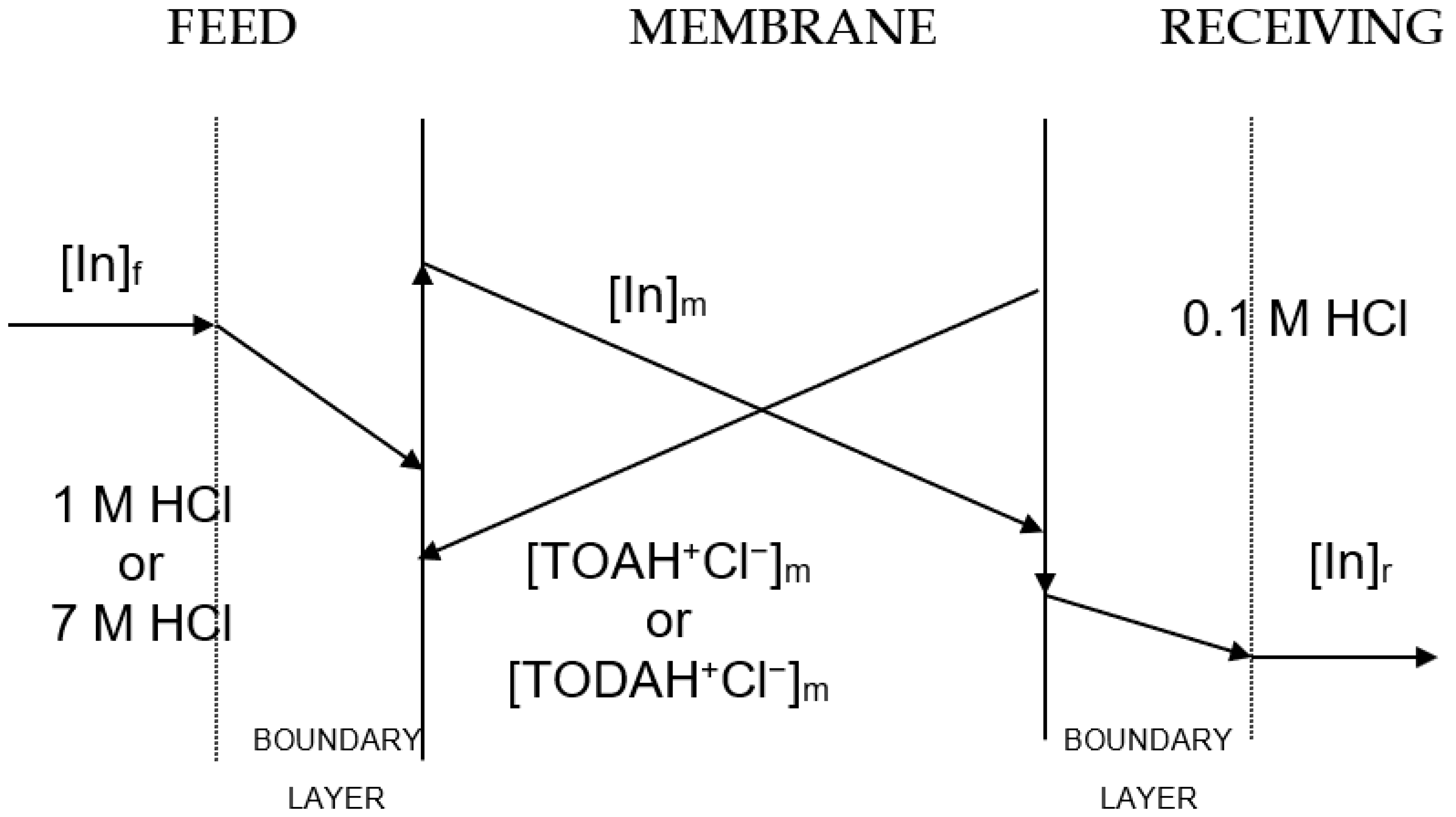
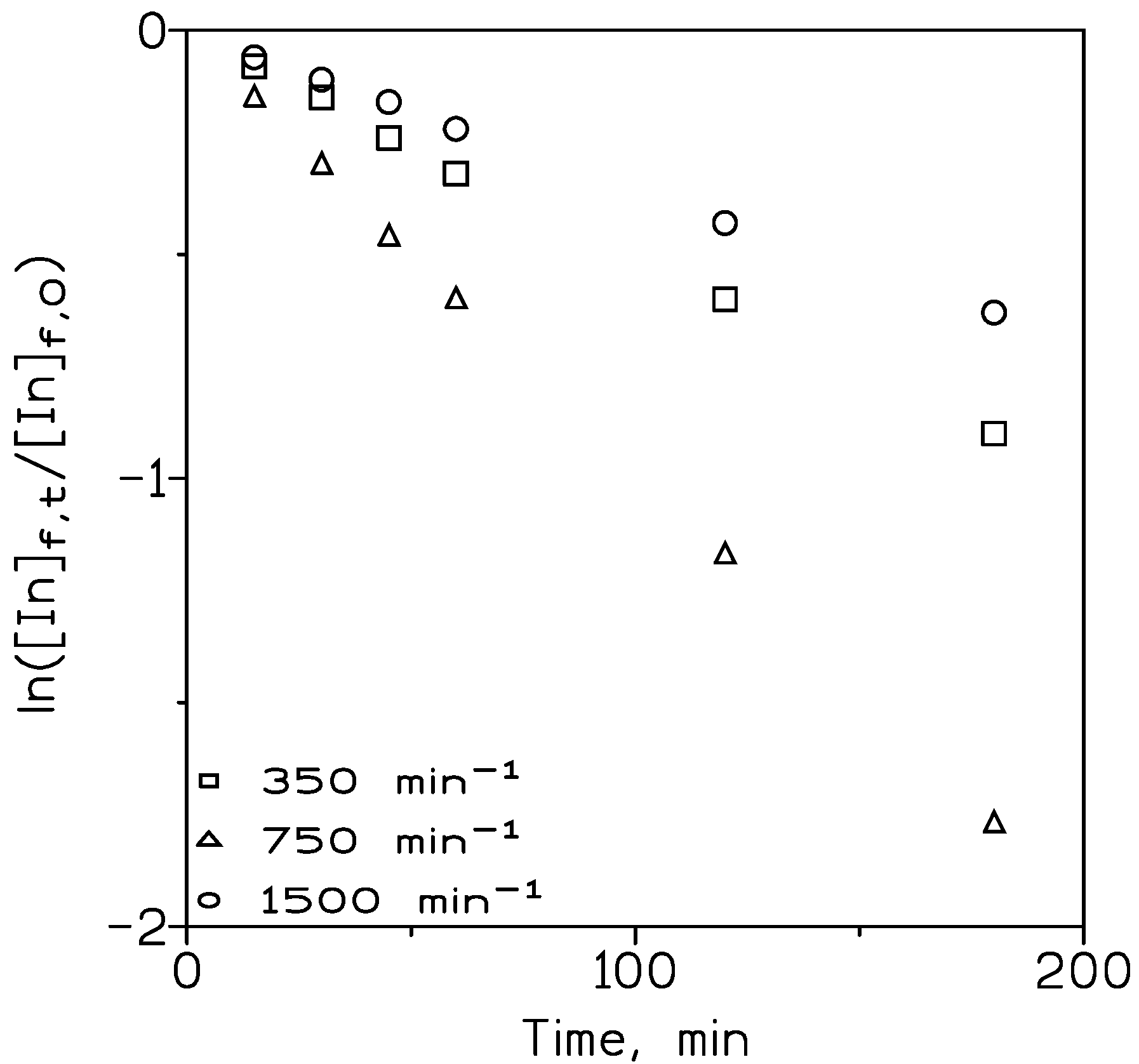
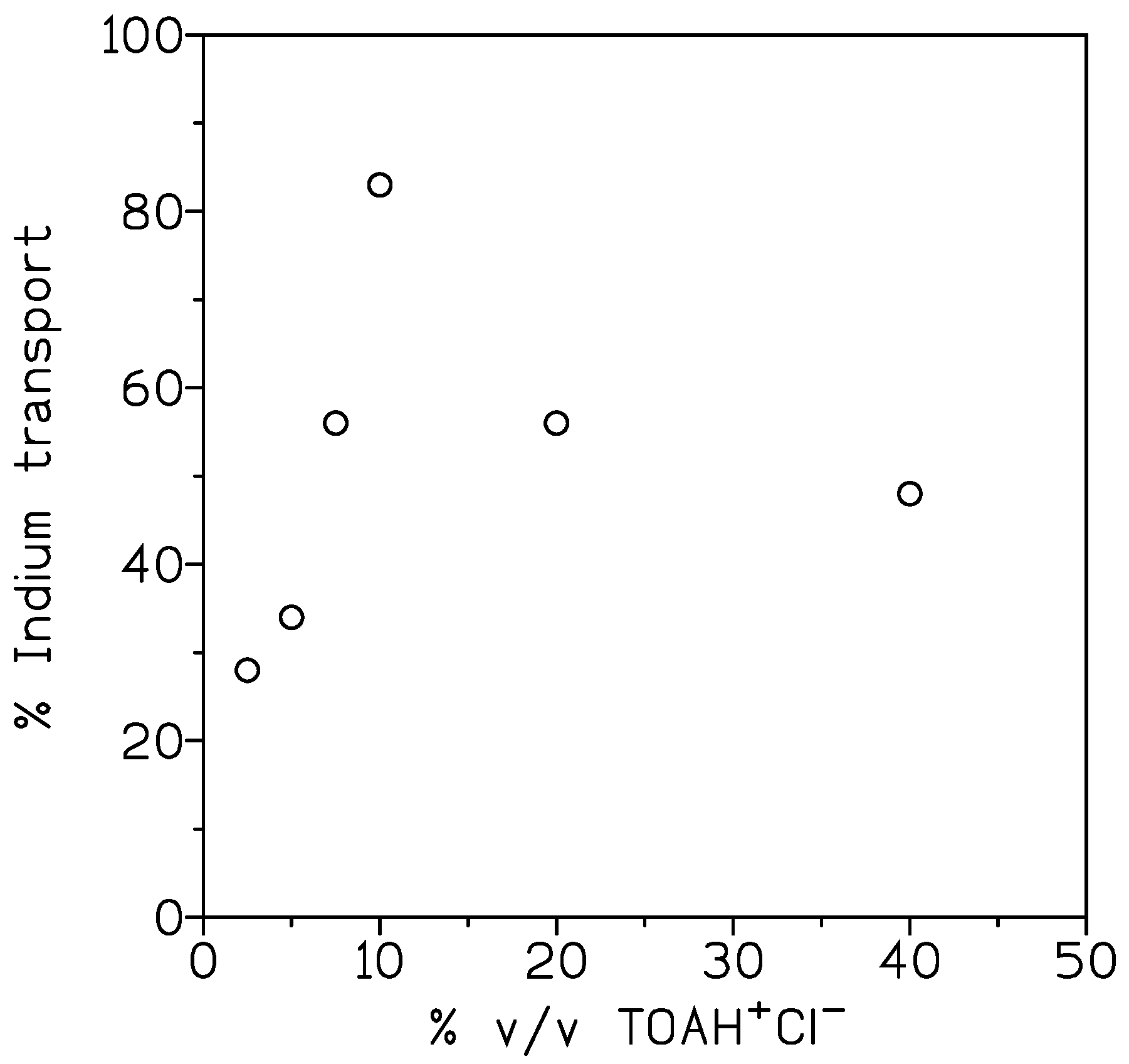
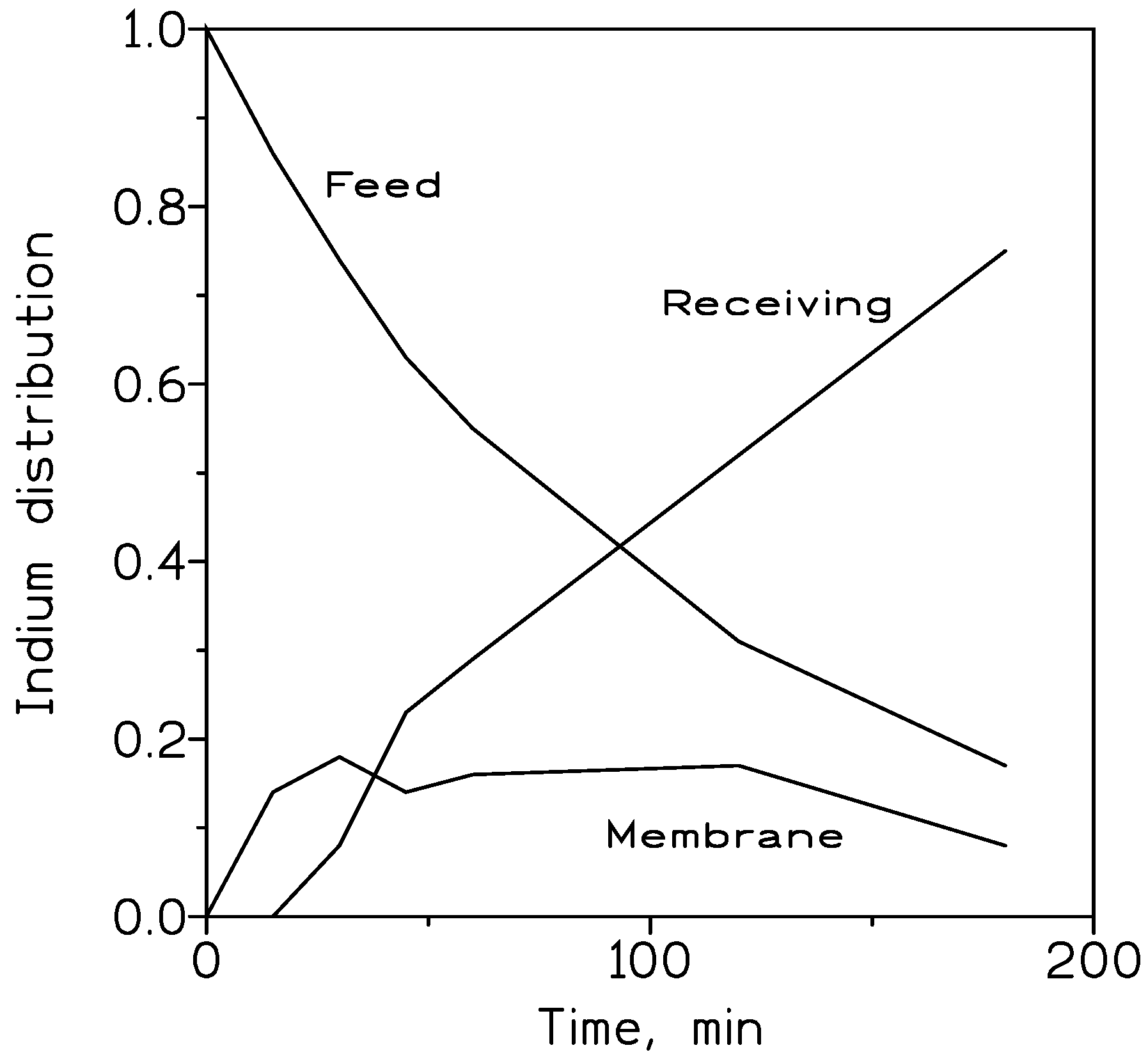
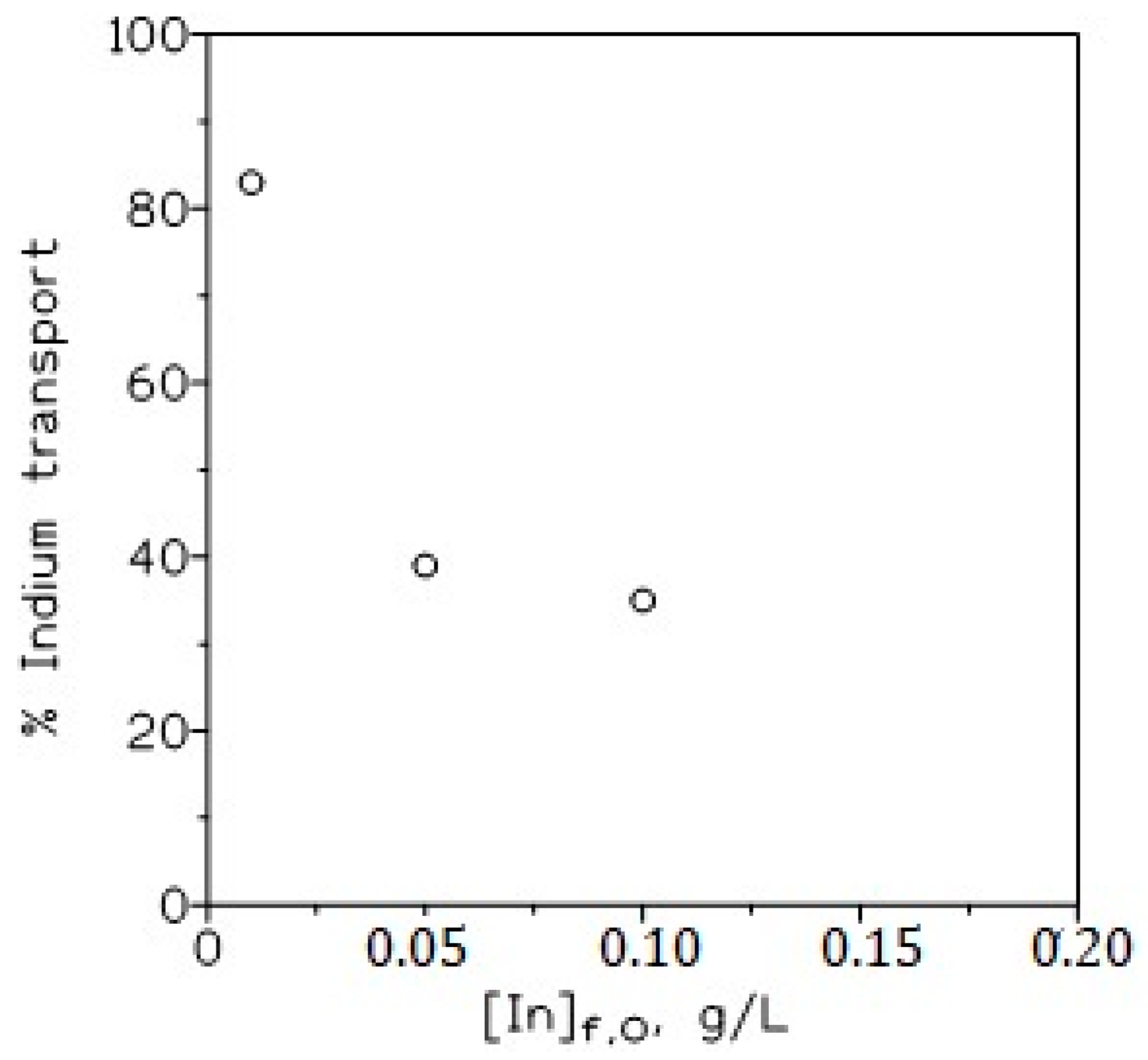
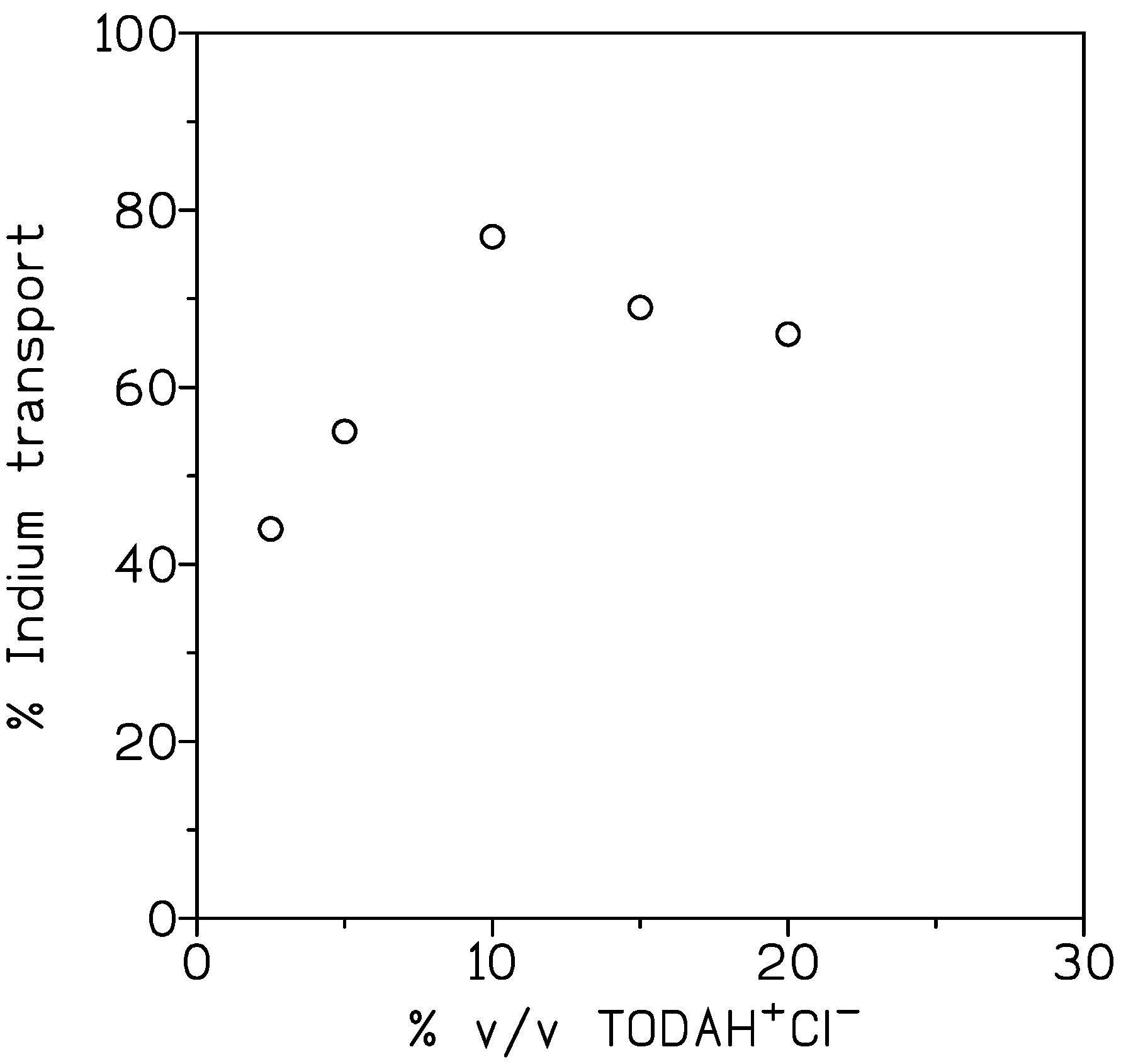
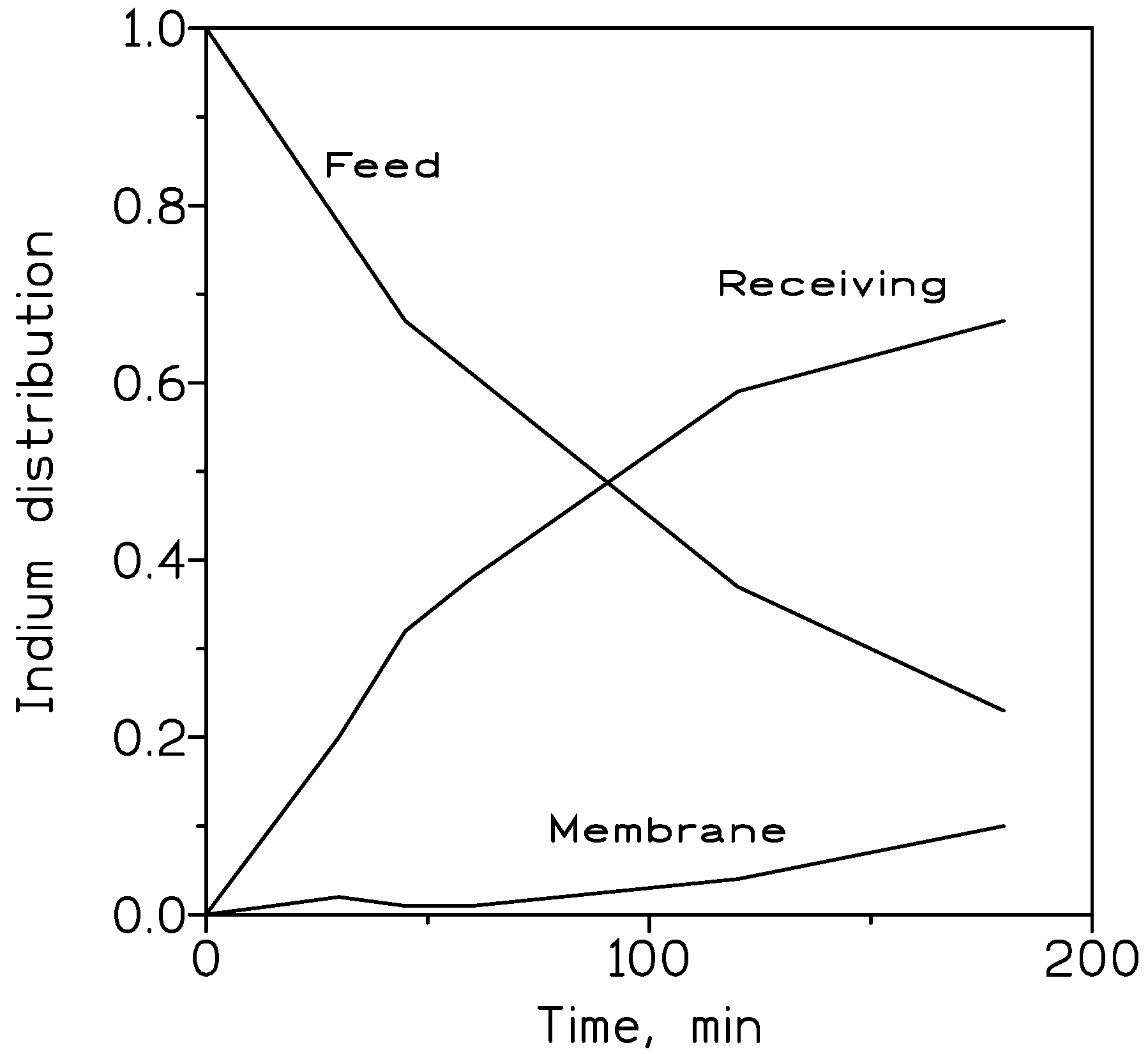

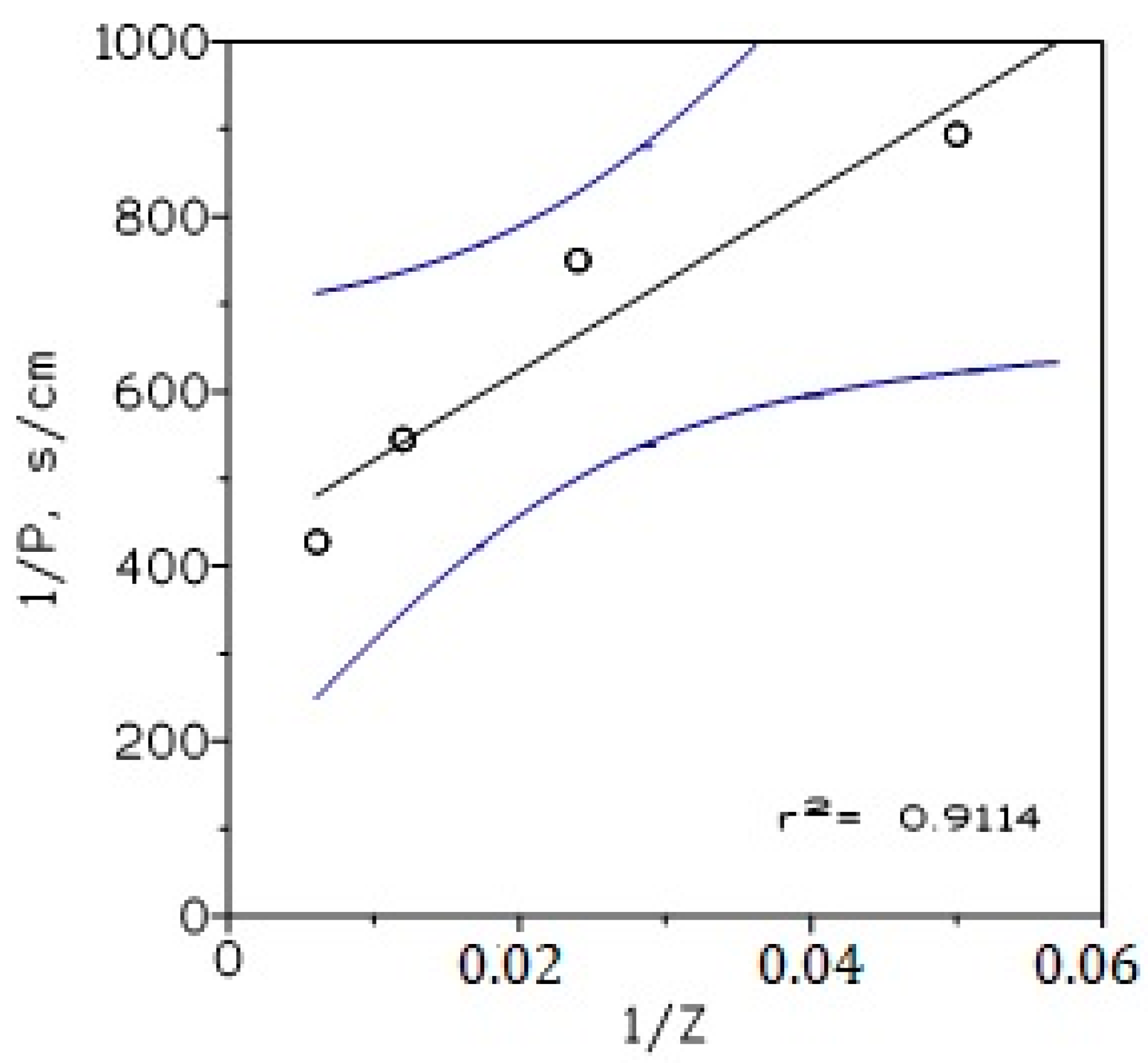
| Stirring Speed, min−1 | Percent Transport |
|---|---|
| 375 | 64 |
| 500 | 73 |
| 750 | 83 |
| 1000 | 63 |
| 1500 | 47 |
| HCl, M | Percent Transport |
|---|---|
| 0.5 | 25 |
| 0.75 | 50 |
| 1 | 83 |
| 2 | 83 |
| 4 | 68 |
| 6 | 60 |
| Stirring Speed, min−1 | Percentage Transport |
|---|---|
| 600 | 55 |
| 800 | 77 |
| 1000 | 77 |
| 1200 | 66 |
| 1500 | 60 |
| Initial Indium(III) Concentration, g/L | Percent Transport Feed Phase to Membrane Phase | Percent Transport Membrane Phase to Receiving Phase |
|---|---|---|
| 0.01 | 77 | 87 |
| 0.05 | 74 | 88 |
| 0.1 | 67 | 90 |
| 0.2 | 62 | 82 |
| Parameter | Value |
|---|---|
| Membrane diffusion coefficient (Dm) | 1.2 × 10−6 cm2/s |
| Diffusion coefficient in the bulk membrane (Db,m) | 4.5 × 10−6 cm2/s |
| Apparent diffusion coefficient in the membrane (Dma) | 1.2 × 10−8 cm2/s |
| Mass transfer coefficient in the feed phase (Δf−1) | 2.3 × 10−3 cm/s |
Disclaimer/Publisher’s Note: The statements, opinions and data contained in all publications are solely those of the individual author(s) and contributor(s) and not of MDPI and/or the editor(s). MDPI and/or the editor(s) disclaim responsibility for any injury to people or property resulting from any ideas, methods, instructions or products referred to in the content. |
© 2022 by the authors. Licensee MDPI, Basel, Switzerland. This article is an open access article distributed under the terms and conditions of the Creative Commons Attribution (CC BY) license (https://creativecommons.org/licenses/by/4.0/).
Share and Cite
Alguacil, F.J.; López, F.A. The Pseudo-Protic Ionic Liquids TOAH+Cl− and TODAH+Cl− as Carriers for Facilitated Transport of In(III) from HCl Solutions. Membranes 2023, 13, 19. https://doi.org/10.3390/membranes13010019
Alguacil FJ, López FA. The Pseudo-Protic Ionic Liquids TOAH+Cl− and TODAH+Cl− as Carriers for Facilitated Transport of In(III) from HCl Solutions. Membranes. 2023; 13(1):19. https://doi.org/10.3390/membranes13010019
Chicago/Turabian StyleAlguacil, Francisco José, and Félix Antonio López. 2023. "The Pseudo-Protic Ionic Liquids TOAH+Cl− and TODAH+Cl− as Carriers for Facilitated Transport of In(III) from HCl Solutions" Membranes 13, no. 1: 19. https://doi.org/10.3390/membranes13010019
APA StyleAlguacil, F. J., & López, F. A. (2023). The Pseudo-Protic Ionic Liquids TOAH+Cl− and TODAH+Cl− as Carriers for Facilitated Transport of In(III) from HCl Solutions. Membranes, 13(1), 19. https://doi.org/10.3390/membranes13010019








